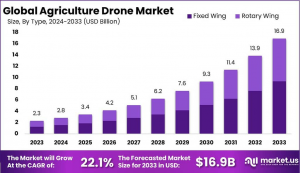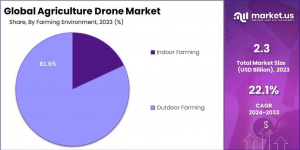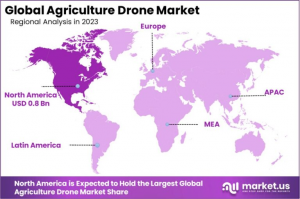Agriculture Drone Market size is expected to be worth around USD 16.9 Billion by 2033, from USD 2.3 Billion in 2023, growing at a CAGR of 22.1%.
North America leads the global agriculture drone market with a 35.3% share, valued at USD 0.8 billion in 2023, thanks to tech advancements and increased farm productivity.”
NEW YORK, NY, UNITED STATES, January 27, 2025 /EINPresswire.com/ -- Market Overview— Tajammul Pangarkar
The Global Agriculture Drone Market size is expected to be worth around USD 16.9 Billion by 2033, from USD 2.3 Billion in 2023, growing at a CAGR of 22.1% during the forecast period from 2024 to 2033. North America dominated a 35.3% market share in 2023 and held USD 0.8 Billion in revenue from the Agriculture Drone Market.
The Agriculture Drone Market refers to the utilization of unmanned aerial vehicles (UAVs) for various agricultural purposes. These drones are equipped with sensors, cameras, and GPS technology to collect real-time data, monitor crop health, optimize irrigation, and assess soil quality. Their applications also extend to precision farming, pest management, and field mapping, offering significant advantages in terms of increased efficiency, reduced labor costs, and improved crop yields.
The agriculture drone market is poised for substantial growth driven by advancements in drone technology and the increasing adoption of precision farming practices. With growing global demand for food, farmers are under pressure to enhance productivity while managing resources more efficiently.
Drones offer a solution by enabling farmers to monitor vast areas of land quickly and gather valuable insights into crop conditions, pest infestations, and irrigation needs. Additionally, the integration of AI, machine learning, and real-time data analytics into drones is transforming agricultural practices, improving decision-making, and boosting operational efficiency.
Governments worldwide are recognizing the potential of drones in revolutionizing agriculture, and there is a notable uptick in investments and regulatory support to foster innovation. These investments are often focused on research and development, as well as initiatives aimed at creating frameworks for drone integration in agricultural sectors.
Furthermore, regulatory bodies are working to streamline drone use in farming, addressing safety and privacy concerns while ensuring drones meet agricultural standards. In many countries, favorable policies and subsidies are encouraging small and medium-sized farms to adopt drone technology.
For both new entrants and established players, the agriculture drone market presents a plethora of opportunities. New players can capitalize on the increasing demand for cost-effective, high-performance drones by offering innovative solutions and technologies.
Existing players can leverage their experience to expand product offerings, enhance customer engagement, and develop strategic partnerships with agricultural firms, technology providers, and government agencies. The focus on research and innovation, especially in AI-powered drones, represents a significant growth avenue, enabling businesses to tap into emerging trends such as data-driven farming, precision irrigation, and autonomous agricultural processes.
Curious About Market Trends? Request Your Complimentary Sample Report Today: https://market.us/report/agriculture-drone-market/free-sample/
Key Takeaway
-- The Global Agriculture Drone Market size is expected to be worth around USD 16.9 Billion by 2033, from USD 2.3 Billion in 2023, growing at a CAGR of 22.1% during the forecast period from 2024 to 2033.
-- In 2023, Fixed Wing held a dominant market position in the By Type segment of the Agriculture Drone Market, with a 55% share.
-- In 2023, Hardware held a dominant market position in the By Component segment of Agriculture Drone Market, with a 52.4% share.
-- In 2023, Outdoor Farming held a dominant market position in the By Farming Environment segment of the Agriculture Drone Market, with an 81.6% share.
-- In 2023, Crop Spraying held a dominant market position in the application segment of the Agriculture Drone Market.
-- North America dominated a 35.3% market share in 2023 and held USD 0.8 Billion in revenue from the Agriculture Drone Market.
Use Cases
Precision Farming: Agriculture drones are revolutionizing the precision farming landscape. Drones equipped with high-resolution cameras and sensors help farmers monitor crop health, detect pests, and assess water levels. This leads to more efficient use of resources, reduced waste, and improved yields, making farming more sustainable and cost-effective.
Crop Monitoring & Management: Farmers are using drones to monitor large fields and gather data on crop health. By analyzing aerial imagery and sensor data, drones can identify areas of stress in crops, whether due to disease, pests, or nutrient deficiencies. This data enables farmers to take corrective actions sooner, improving crop quality and reducing chemical use.
Field Mapping & Surveying: Drones are valuable tools for mapping large agricultural fields. Through photogrammetry and geospatial technology, drones can create detailed maps of farms, helping farmers plan irrigation, planting, and fertilization. This information improves decision-making and enhances land management practices.
Irrigation Management: Drones with thermal imaging capabilities can monitor soil moisture levels across vast fields. This helps farmers optimize irrigation schedules, ensuring that crops receive adequate water while avoiding overuse of resources. Precision irrigation reduces water wastage and can lower irrigation costs.
Pest and Disease Control: Drones can detect early signs of pest infestations or plant diseases, enabling farmers to target specific areas with pesticide or herbicide. By using drones to focus on affected zones, farmers can reduce chemical usage and mitigate environmental impact, improving the overall sustainability of their farming practices.
Driving Factors
Increasing Demand for Precision Farming
The adoption of precision agriculture techniques is growing rapidly as farmers look for ways to increase crop yields while reducing waste and costs. Drones equipped with advanced sensors and cameras allow farmers to monitor crop health, soil conditions, and irrigation needs in real-time. This level of detailed, data-driven insight is pushing the demand for agricultural drones, as they help optimize farming practices.
Advancements in Drone Technology
As drone technology continues to improve, the capabilities of agricultural drones have expanded. Modern drones come equipped with high-resolution cameras, multispectral imaging, and GPS tracking, allowing for more precise crop management. The development of autonomous flight systems and AI-powered analytics is making drones more user-friendly and efficient, driving their adoption in agriculture.
Government Support and Incentives
Governments worldwide are offering incentives and subsidies to encourage the adoption of innovative technologies like drones in agriculture. These initiatives aim to boost farm productivity and sustainability, making drones more accessible to farmers. Additionally, regulations that support drone usage in agricultural settings, including relaxation of airspace restrictions, are helping to drive market growth.
Cost-Effective Monitoring and Management
Agriculture drones reduce the need for manual labor and large-scale equipment like tractors or planes for field surveillance, lowering operational costs. Drones can cover large areas quickly and efficiently, making them a cost-effective solution for farmers, especially in remote or hard-to-reach locations. This has made drones an attractive investment for farms of all sizes.
Rising Focus on Sustainable Farming
Sustainability is a key driver of growth in the agriculture drone market. Drones can help farmers reduce the use of pesticides, fertilizers, and water by enabling more precise applications. By providing accurate data on crop health and resource needs, drones help minimize waste and environmental impact, supporting sustainable farming practices.
Report Segmentation
In 2023, the Agriculture Drone Market was led by the Fixed Wing type, which captured 55% of the market. Its dominance is due to its long range and endurance, making it ideal for large-scale agricultural monitoring and data collection.
In the By Component segment, Hardware held a 52.4% share, including critical components like Frames, Flight Control Systems, Navigation Systems, Propulsion Systems, Cameras, and Sensors, all essential for drone functionality.
Outdoor Farming dominated the By Farming Environment segment with 81.6% market share, reflecting the widespread use of drones in outdoor settings for tasks like crop monitoring, field mapping, pesticide spraying, and irrigation.
Crop Spraying led the By Application segment, as it offers precise and efficient pesticide, herbicide, and fertilizer distribution, improving crop health and yield while reducing chemical usage and environmental impact.
By Type
• Fixed Wing
• Rotary Wing
By Component
• Hardware
Frames
Flight Control Systems
Navigation Systems
Propulsion Systems
Cameras
Sensors
Others
• Software
• Services
Professional Services
Managed Services
By Farming Environment
• Indoor Farming
• Outdoor Farming
By Application
• Crop Management
• Field Management
• Crop Spraying
• Livestock Monitoring
• Variable Rate Application (VRA)
• Others
Ready to Act on Market Opportunities? Buy Your Report Now and Get 30% off: https://market.us/purchase-report/?report_id=24694
Regional Analysis
In the global agriculture drone market, North America emerged as the leader, holding a 35.3% market share valued at USD 0.8 billion. This growth is fueled by advanced technology, significant investments in research and development, and regulatory support. Farmers in the region increasingly use drones for monitoring crops, analyzing data, and improving productivity, making North America a hub for agricultural innovation.
Growth Opportunities
Increased Demand for Precision Farming As the need for higher crop yields and reduced resource waste grows, agriculture drones are being used to gather real-time data for precision farming. Drones equipped with sensors can monitor soil health, water levels, and crop conditions, leading to more efficient use of inputs like water and fertilizers.
Government Support and Subsidies Many governments are offering incentives and subsidies to support the adoption of technology in agriculture. Drones, as part of precision agriculture, can benefit from these programs, making them more affordable and accessible to farmers worldwide.
Technological Advancements in Drone Capabilities Advances in drone technology, such as improved battery life, better sensors, and AI-powered data analytics, are enhancing their efficiency in farming. As these technologies improve, drones can perform more complex tasks like crop spraying and disease detection, boosting their adoption.
Sustainability Focus in Agriculture Agriculture drones can help farmers reduce their environmental impact by optimizing the use of water, fertilizers, and pesticides. This focus on sustainability and reducing the carbon footprint aligns with the growing demand for eco-friendly farming practices, creating significant growth opportunities in the drone market.
Rising Adoption in Emerging Markets As agriculture practices modernize in emerging markets, there is increasing demand for advanced farming technologies. Drones are becoming a popular tool in countries in Asia-Pacific, Latin America, and Africa, where farmers are looking to enhance productivity while keeping costs low.
Key Players
• Drone Deploy
• DJI
• GoPro
• Precision Hawk
• AeroVironment Inc.
• Trimble Inc.
• 3D Robotics
• Ageagle Aerial Systems, Inc.
• Parrot Drone
• Sintera LLC.
• Delair Tech SAS
• Other Key Players
Not Sure? Request a Sample Report and See How Our Insights Can Drive Your Business: https://market.us/report/agriculture-drone-market/free-sample/
Trending Factors
Advancements in Drone Technology
Technology improvements, such as enhanced battery life, better sensors, and improved GPS systems, are boosting the effectiveness of agricultural drones. These technological advancements allow drones to capture more accurate data and perform complex tasks, such as crop monitoring, soil analysis, and pesticide spraying, making them invaluable tools for modern farming.
Precision Agriculture Adoption
As farmers look for ways to increase productivity and reduce waste, precision agriculture techniques are gaining traction. Drones provide real-time data that helps farmers make data-driven decisions, optimizing irrigation, fertilization, and pest control. This trend toward precision farming is driving the adoption of drones in the agriculture sector, especially in large-scale operations.
Cost-Effectiveness and Efficiency
Drones can help farmers cut costs by increasing efficiency and reducing the need for manual labor. Tasks such as crop monitoring, soil analysis, and pesticide application can be completed more quickly and accurately with drones, allowing farmers to allocate resources more effectively. Over time, drones can reduce the overall costs associated with crop management.
Government Support and Subsidies
Many governments are supporting the use of drones in agriculture through grants, subsidies, or incentives. This support encourages farmers to adopt drone technology, which can lead to more efficient and sustainable farming practices. Government policies aimed at improving agricultural productivity are contributing to the growth of the agriculture drone market.
Growing Demand for Sustainable Farming Practices
With increased pressure on agriculture to adopt more sustainable practices, drones are becoming a critical tool for environmentally friendly farming. Drones enable precision application of water, fertilizer, and pesticides, minimizing waste and reducing environmental impact. As sustainability becomes a priority for consumers and regulators, the demand for drones that support sustainable farming is rising.
Restraining Factors
High Initial Investment
Agriculture drones can be expensive due to the technology involved, such as advanced sensors, GPS systems, and high-resolution cameras. This high upfront cost limits adoption among small-scale farmers and makes it challenging for the market to reach its full potential, particularly in developing regions with lower purchasing power.
Regulatory Barriers
In many countries, drones are subject to strict regulations regarding airspace and safety standards. These regulations can create hurdles for farmers looking to incorporate drones into their operations. The complexity and cost of obtaining the necessary approvals can slow the adoption of agricultural drones, particularly in regions where drone regulations are still evolving.
Conclusion
In conclusion, the Global Agriculture Drone Market is poised for remarkable growth, with a projected CAGR of 22.1% from 2024 to 2033, driven by advancements in drone technology, increasing adoption of precision farming, and growing demand for sustainable agricultural practices. The market presents significant opportunities for both new entrants and established players, especially with the support of government incentives and technological innovations. However, challenges such as high initial investments and regulatory barriers remain, particularly in emerging markets and smaller-scale farms. As drones continue to transform farming practices, their integration into global agriculture will be crucial for enhancing productivity and sustainability in the sector.
Related Report
Wagon Tipplers Market: https://market.us/report/wagon-tipplers-market/
Cream Separator Market: https://market.us/report/cream-separator-market/
Blowing Torch Market: https://market.us/report/blowing-torch-market/
Ceiling Fans Market: https://market.us/report/ceiling-fans-market/
Automated Test Equipment Market: https://market.us/report/automated-test-equipment-market/
Lawrence John
Prudour
+91 91308 55334
Lawrence@prudour.com
Visit us on social media:
Facebook
LinkedIn
Legal Disclaimer:
EIN Presswire provides this news content "as is" without warranty of any kind. We do not accept any responsibility or liability for the accuracy, content, images, videos, licenses, completeness, legality, or reliability of the information contained in this article. If you have any complaints or copyright issues related to this article, kindly contact the author above.




